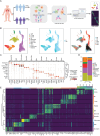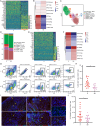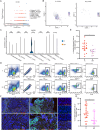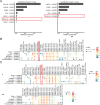CXCR6-positive circulating mucosal-associated invariant T cells can identify patients with non-small cell lung cancer responding to anti-PD-1 immunotherapy
- PMID: 38698468
- PMCID: PMC11067263
- DOI: 10.1186/s13046-024-03046-3
CXCR6-positive circulating mucosal-associated invariant T cells can identify patients with non-small cell lung cancer responding to anti-PD-1 immunotherapy
Abstract
Background: Mucosal-associated invariant T (MAIT) cells have been reported to regulate tumor immunity. However, the immune characteristics of MAIT cells in non-small cell lung cancer (NSCLC) and their correlation with the treatment efficacy of immune checkpoint inhibitors (ICIs) remain unclear.
Patients and methods: In this study, we performed single-cell RNA sequencing (scRNA-seq), flow cytometry, and multiplex immunofluorescence assays to determine the proportion and characteristics of CD8+MAIT cells in patients with metastatic NSCLC who did and did not respond to anti-PD-1 therapy. Survival analyses were employed to determine the effects of MAIT proportion and C-X-C chemokine receptor 6 (CXCR6) expression on the prognosis of patients with advanced NSCLC.
Results: The proportion of activated and proliferating CD8+MAIT cells were significantly higher in responders-derived peripheral blood mononuclear cells (PBMCs) and lung tissues before anti-PD-1 therapy, with enhanced expression of cytotoxicity-related genes including CCL4, KLRG1, PRF1, NCR3, NKG7, GZMB, and KLRK1. The responders' peripheral and tumor-infiltrating CD8+MAIT cells showed an upregulated CXCR6 expression. Similarly, CXCR6+CD8+MAIT cells from responders showed higher expression of cytotoxicity-related genes, such as CST7, GNLY, KLRG1, NKG7, and PRF1. Patients with ≥15.1% CD8+MAIT cells to CD8+T cells ratio and ≥35.9% CXCR6+CD8+MAIT cells to CD8+MAIT cells ratio in peripheral blood showed better progression-free survival (PFS) after immunotherapy. The role of CD8+MAIT cells in lung cancer immunotherapy was potentially mediated by classical/non-classical monocytes through the CXCL16-CXCR6 axis.
Conclusion: CD8+MAIT cells are a potential predictive biomarker for patients with NSCLC responding to anti-PD-1 therapy. The correlation between CD8+MAIT cells and immunotherapy sensitivity may be ascribed to high CXCR6 expression.
Keywords: CXCR6; Circulating mucosal-associated invariant T cells; Immunotherapy; Non-small cell lung cancer; Single-cell RNA-sequencing.
© 2024. The Author(s).
Conflict of interest statement
The authors declare that there are no conflicts of interest.
Figures







Similar articles
-
Clinicopathological and predictive value of MAIT cells in non-small cell lung cancer for immunotherapy.J Immunother Cancer. 2023 Jan;11(1):e005902. doi: 10.1136/jitc-2022-005902. J Immunother Cancer. 2023. PMID: 36657812 Free PMC article.
-
CD161+CD127+CD8+ T cell subsets can predict the efficacy of anti-PD-1 immunotherapy in non-small cell lung cancer with diabetes mellitus.Oncoimmunology. 2024 Jun 27;13(1):2371575. doi: 10.1080/2162402X.2024.2371575. eCollection 2024. Oncoimmunology. 2024. PMID: 38952673 Free PMC article.
-
MAIT cells are associated with responsiveness to neoadjuvant immunotherapy in COPD-associated NSCLC.Cancer Med. 2024 Mar;13(6):e7112. doi: 10.1002/cam4.7112. Cancer Med. 2024. PMID: 38509769 Free PMC article.
-
Safety and Efficacy of PD-1/PD-L1 inhibitors combined with radiotherapy in patients with non-small-cell lung cancer: a systematic review and meta-analysis.Cancer Med. 2021 Feb;10(4):1222-1239. doi: 10.1002/cam4.3718. Epub 2021 Jan 19. Cancer Med. 2021. PMID: 33465302 Free PMC article.
-
Single or combined immune checkpoint inhibitors compared to first-line platinum-based chemotherapy with or without bevacizumab for people with advanced non-small cell lung cancer.Cochrane Database Syst Rev. 2020 Dec 14;12(12):CD013257. doi: 10.1002/14651858.CD013257.pub2. Cochrane Database Syst Rev. 2020. Update in: Cochrane Database Syst Rev. 2021 Apr 30;4:CD013257. doi: 10.1002/14651858.CD013257.pub3. PMID: 33316104 Free PMC article. Updated.
Cited by
-
Circulating mucosa-associated invariant T cells are decreased and have impaired function in patients with diffuse large B-cell lymphoma.Transl Oncol. 2025 Sep;59:102461. doi: 10.1016/j.tranon.2025.102461. Epub 2025 Jun 27. Transl Oncol. 2025. PMID: 40580872 Free PMC article.
-
Mucosal-associated invariant T-cells in pulmonary pathophysiology.Curr Opin Pulm Med. 2025 May 1;31(3):202-210. doi: 10.1097/MCP.0000000000001163. Epub 2025 Mar 19. Curr Opin Pulm Med. 2025. PMID: 40104908 Free PMC article. Review.
-
TRAIL induces cytokine production via the NFkB2 pathway promoting neutrophil chemotaxis and neutrophil-mediated immune-suppression in triple negative breast cancer cells.Cancer Lett. 2025 Jun 28;620:217692. doi: 10.1016/j.canlet.2025.217692. Epub 2025 Apr 3. Cancer Lett. 2025. PMID: 40187604
-
A novel Tc17 population recruited by tumor cells promotes tumor progression in gastric cancer.Front Oncol. 2025 May 16;15:1592328. doi: 10.3389/fonc.2025.1592328. eCollection 2025. Front Oncol. 2025. PMID: 40452847 Free PMC article.
-
Cystatin F-a key player in central nervous system disease.J Neuroinflammation. 2025 Aug 14;22(1):203. doi: 10.1186/s12974-025-03526-z. J Neuroinflammation. 2025. PMID: 40813983 Free PMC article. Review.
References
-
- Travis WD, Brambilla E, Nicholson AG, Yatabe Y, Austin JHM, Beasley MB, Chirieac LR, Dacic S, Duhig E, Flieder DB, et al. The 2015 World Health Organization Classification of Lung Tumors: impact of genetic, clinical and radiologic advances since the 2004 classification. J Thorac Oncol. 2015;10(9):1243–60. doi: 10.1097/JTO.0000000000000630. - DOI - PubMed
MeSH terms
Substances
Grants and funding
LinkOut - more resources
Full Text Sources
Medical
Research Materials

